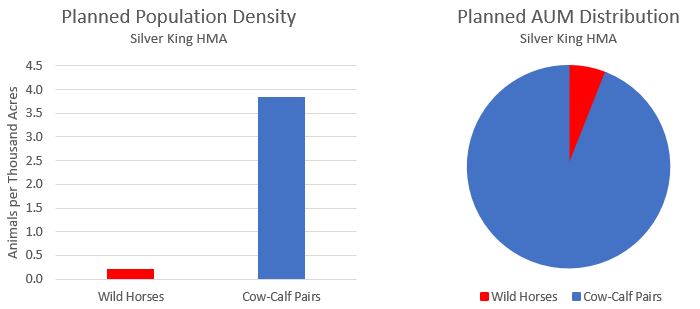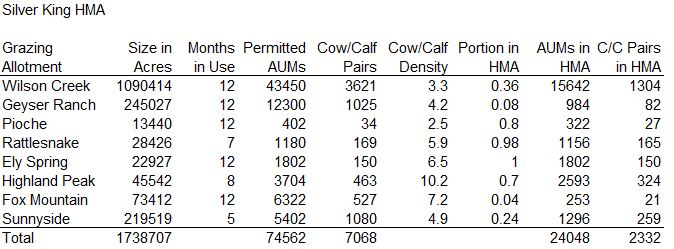The announcement yesterday of a gather involving the Silver King HMA, among others, included a link to the final environmental assessment for a large roundup that occurred there in late 2018.
The EA looks at the effects of a proposed action along with those of its alternatives.
Table 1 on page 5 of the document says the HMA has an AML of 128 wild horses and a size of 606,000 acres, for an aimed-at population density of 0.2 animals per thousand acres. The average density for all HMAs is one animal per thousand acres (27,000 wild horses and burros on 27 million acres).
The 128 horses allowed by plan would consume 1,536 AUMs annually, given they graze 12 months per year.
Table 3.3 on page 73, titled ‘Grazing Use Within Silver King Herd Management Area,’ shows eight livestock grazing allotments overlapping the HMA. Only four percent of the Fox Mountain allotment falls within the HMA, compared to Ely Spring, which lies completely within the HMA.
The forage allocated to livestock must be calculated according to the percentage of land falling within the HMA. For example, the Wilson Creek allotment contributes 43,450 × 0.36 = 15,642 AUMs, because 36% of its land is inside the HMA (assuming that forage is uniformly distributed across the parcel).
The eight fractions, added together, yield 24,048 AUMs for livestock inside the HMA.
In a similar manner, the forage allocations can be converted to cow/calf pairs using the annual grazing period (also given in table 3.3). Wilson Creek livestock graze 12 months per year, so the number of cow/calf pairs inside the HMA would be 15,642 ÷ 12 = 1,304.
These eight results yield 2,332 cow/calf pairs inside the HMA, for a population density of 3.8 animals per thousand acres. Note that one cow/calf pair is equivalent to one wild horse in terms of its resource loading.
These figures are presented in the following charts:

Land that can only support 0.2 wild horses per thousand acres can support eighteen times as many privately owned livestock. Wild horses receive 1/15 (6%) of the forage allocated to livestock.
There’s your thriving ecological balance, on land set aside for the horses.
These alternatives were rejected in section 2.6 of the EA:
- Raising the AML
- Reducing or removing livestock
- Managing the HMA principally for wild horses
Instead, the plan calls for additional roundups, fertility control and sex ratio skewing.
Table 3.3 in the EA also gives the allotment sizes, from which the planned population densities can be computed. First, determine the number of cow/calf pairs on each allotment (inside and outside the HMA) using the permitted AUMs and annual grazing periods. Then, divide those results by the size of the allotments.
For example, the number of cow/calf pairs on Wilson Creek, allowed by plan, would be 43,450 ÷ 12 = 3,621. The population density would be 3,621 ÷ 1,090,414 × 1,000 = 3.3 pairs per thousand acres.

Note that the Ely Spring allotment, all of which falls within the HMA, can support 32 times as many cow/calf pairs as wild horses (6.5 ÷ 0.2).
These data provide more evidence that the WHB Act, which has been altered several times by ranching interests, no longer affords the protections sought by Velma.
The numbers also suggest that AMLs do not reflect the carrying capacity of the land.
